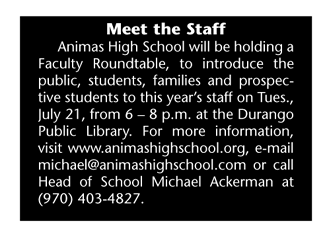|
| ||||
| Charting a new course SideStory: Out of the box: Animas High School eyes opening day
by Missy Votel As Durango’s newest charter school prepares to welcome its first freshman class this fall, local middle schoolers may soon have a charter option as well. Mountain Middle School has announced plans for an August 2010 opening date, pending charter approval. The school, which will serve sixth- through eighth-graders, will be based on the same model as Animas High School: the innovative Calif.-based High Tech High. However, Mountain Middle School organizers stressed the two schools will be separate entities, with individual staffs, governing bodies and facilities. “It made sense to separate the schools,” said Mountain Middle School Steering Committee Chairwoman Nancy Heleno. “Middle school is such a distinct time in intellectual and emotional growth and the development during middle school is so disparate from high school.” Also the facilities coordinator for Animas High School, Heleno said she will be leaving her post at AHS this fall to pursue middle school duties full time. “I didn’t want to dilute the focus by dispersing my energies,” she said. Mountain Middle School, or MMS, is in the process of compiling its application to the Colorado Charter School Institute. School leaders expect to submit the application by Sept. 1 and have an answer by the end of October. As part of the application process, MMS must first demonstrate community interest, and letters of intent started “trickling out” last week, Heleno said. So far, feedback has been encouraging. “We’ve gotten very positive response,” she said. “So far, the overriding message is, ‘Options in education are good. Let me know more.’” As a charter school, the MMS would be semi-autonomous – able to set its own curriculum, calendar and policies and select its own staff and board of directors. However, as a public school, it would still receive state per pupil funding. The school will be based upon a successful charter model in Southern California, High Tech High. The first High Tech High opened in 2000 in San Diego, stressing the use of technology and real-world situations as a means to an end in the learning process. The school was so successful that it was replicated throughout the state and now boasts 2,500 students in five high schools, two middle schools and one elementary school. The high schools have an 100 percent college acceptance rate, 80 percent of that to four-year schools.Heleno said Mountain Middle School will operate under a similar mission, integrating technology and project-based learning into a rigorous liberal arts curriculum to “prepare students to succeed in the 21st Century as self-motivated, innovative thinkers who seek to resolve challenges collaboratively.” An author and researcher on childhood brain development, Heleno said she became interested in the High Tech High model while teaching college courses back East. “I taught the same course at two colleges simultaneously, using the same book and same curriculum,” she said. “The disparities in the college preparedness between students at the two schools was troubling.”As a result, Heleno became interested in different curriculum models, but it was High Tech High that made the most sense to her. “Basically, it comes down to neurology. Humans are not wired to learn by being lectured at,” she said. “We need to be able to listen, collaborate, be allowed to fail, touch, see, hear and ask questions. The more you use those things, the stronger your memory, and problem-solving skills will be.” MMS would seek to raise the bar for achievement by engaging students in smaller, individualized classes and cap enrollment at 50 students per grade using a lottery system. Although the charter school’s curriculum would be different from district schools, it would still be rooted in state standards. Students would be given and letter grade and also ranked on a “rubric” scale, which outlines steps in becoming proficient in a certain area. For example, instead of simply learning math straight from a book, students are given an actual project, such as designing and building a scale model of a structure. Different groups are assigned tasks of varying difficulty based upon their grasp of the concepts, and as Heleno stressed, failure is not always a bad thing. “When kids are allowed to fail, it’s a learning process,” she said. “Many people got to places they never intended to find by accident. Fabulous things can come out of that process.” • For more information on Mountain Middle School, to volunteer or to sign a letter of intent, please e-mail Heleno at mountainmiddleschool@yahoo.com.
|



